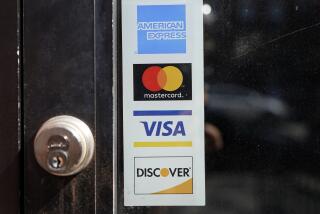U.S. trade gap hits new record
- Share via
WASHINGTON — The huge U.S. current account deficit widened in the third quarter to a record $225.6 billion, as gushing oil prices and strong demand for Chinese and other foreign goods pushed imports higher, a Commerce Department report showed Monday.
The quarterly shortfall surpassed the previous record of $223.1 billion in the fourth quarter of 2005 but was largely in line with expectations before the report. The gap, on an annual basis, topped $900 billion for the first time, but some analysts saw signs that it was receding already.
The current account, the broadest measure of U.S. trade with the rest of the world, includes trade in goods, services and investment flows. The huge deficit is viewed as one of the major risks to the world economy, along with surpluses in Asian and oil-exporting countries.
“We think that the deficit has peaked,” said Nigel Gault, chief U.S. economist with Global Insight. “Lower oil prices, robust export growth and some cooling in import growth should bring the deficit down, beginning in the fourth quarter.”
Meanwhile, a second report showed that home builders remained glum about current sales but hopeful of better conditions by the middle of next year.
The National Assn. of Home Builders/Wells Fargo Housing Market index fell 1 point to 32 but held above the 15-year low of 30 reached in September. Any reading below 50 means most builders view market conditions as poor.
However, lower mortgage rates have made many home builders less gloomy about the next six months. An index measuring sales expectations rose for the third consecutive month, to 48 from 45. That brought it to its highest level since June.
More than half of the increase in the third-quarter current account deficit came from higher oil prices.
Strong worldwide demand and tensions in the Middle East propelled average U.S. oil import prices to a record $66.12 a barrel in August, before they began to slide.
Sherry Cooper, chief economist at BMO Capital Markets, called the U.S. current account shortfall a “$900-billion gorilla” looming over the U.S. economy. The third-quarter gap, as a percentage of U.S. gross domestic product, was the second-highest on record at 6.8%, up from 6.6% in the second quarter.
“The expected modest improvement in the current account deficit is not that encouraging since the overall shortfall will remain very large [both in dollar terms and as a share of GDP], keeping external financing risks elevated,” Cooper said.
The goods deficit -- the largest portion of the current account deficit -- increased to $218.6 billion in the third quarter from $210.6 billion in the second.
U.S. goods exports increased to $262.1 billion from $252.8 billion, with gains in all major commodity areas.
But that was overshadowed by goods imports, which increased to $480.7 billion from $463.4 billion, driven by increases in petroleum, the weak performance of U.S. automakers and demand for Chinese and other foreign goods, analysts said.
More to Read
Inside the business of entertainment
The Wide Shot brings you news, analysis and insights on everything from streaming wars to production — and what it all means for the future.
You may occasionally receive promotional content from the Los Angeles Times.










